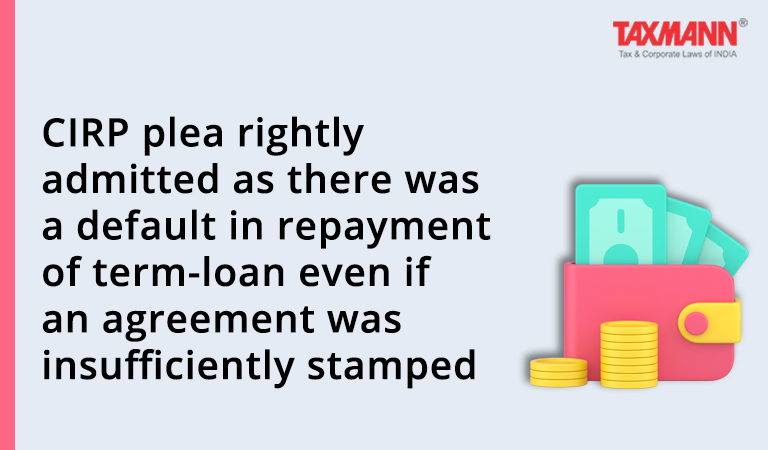CIRP plea rightly admitted as there was a default in repayment of term-loan even if an agreement was insufficiently stamped
- Blog|News|Insolvency and Bankruptcy Code|
- 3 Min Read
- By Taxmann
- |
- Last Updated on 19 October, 2021
Case Details: Ashique Ponnamparambath v. Federal Bank Ltd. - [2021] 131 taxmann.com 72 (NCLAT - Chennai)
Judiciary and Counsel Details
-
- Venugopal M., Judicial Member and V. P. Singh, Technical Member
- R. Murari, Sr. Adv. and Ms. Ramya Subramaniam, Adv. for the Appellant.
Facts of the Case
The appellant was an ex-director of the corporate debtor engaged in the sale of vehicles and the Respondent/financial creditor entered into a term loan agreement dated 30-6-2014 with the corporate debtor. The term loan agreement contained various ancillary provisions that in effect sought to create a charge of the respondent over the assets of the corporate debtor as security for the loan extended under the ‘term loan agreement’.
The financial creditor, on the other hand, contended that on 30-6-2019, the corporate debtor had availed, among other things, a term loan of Rs. ten crores with an agreement to repay the same in 120 monthly installments together with interest and charges outlined in the loan document.
The corporate debtor as collateral security for the debt created an equitable mortgage favoring the applicant. However, due to default in monthly installments, the corporate debtor account status regarding the credit facility changed to a Non-Performing Asset.
Therefore, the financial creditor issued a demand notice to the corporate debtor requiring it to repay the outstanding loan amount. However, the corporate debtor failed to pay the amount demanded.
On being aggrieved, the financial creditor filed a petition under section 7 of the Insolvency and Bankruptcy Code, 2016 for initiation of corporate insolvency resolution process against the corporate debtor. The NCLT by impugned order admitted said petition.
The appellant-corporate debtor filed an appeal against an order of NCLT on the ground that the petition filed under section 7 was not maintainable because the entire loan transaction was based on the ‘term loan agreement’, which was an inadequately stamped document and, therefore, was inadmissible in evidence.
NCLAT Held
Based on the documents filed by the financial creditor, the NCLAT stated that the financial creditor has proved that the corporate debtor has defaulted in making the payment due on the corporate debtor. Therefore, if it is considered that the term loan agreement is insufficiently stamped for argument stake, then it is inadmissible in evidence. Furthermore, the claim of the financial creditor is fully corroborated by other evidence filed.
In addition to foregoing, the corporate debtor committed default in repayment of the loan amount to the financial creditor. Hence its loan account was declared as NPA. In light of facts and circumstances, debt and default are reasonably established by the financial creditor and the application filed by the financial creditor under sub-section (4) of section 7 was complete in all respects. Therefore, the Adjudicating Authority admitted the petition filed under section 7 of the Insolvency and Bankruptcy Code, 2016.
However, the objections raised by the appellant/corporate debtor are unsustainable as the appellant emphasized the alleged insufficiently stamped term loan agreement. However, in addition to the term loan agreement, the financial creditor relies on Demand Promissory Note, Hypothecation letter regarding depositing of title deed, a certified copy of the bank statement, and so many other documents filed along with the application. Therefore, even if it is considered that the term loan agreement is insufficiently stamped and it cannot be accepted in evidence, then also alleged debt and default are proved beyond doubt. Furthermore, the application filed under section 7 is complete. Thus, there is no merit in the appeal, and the same is liable to be dismissed.
Case Review
-
- Federal Bank Ltd. v. Platino Classic Motors (India) (P.) Ltd. [2021] 131 taxmann.com 71 (NCLT – Kochi) (para 29) affirmed
List of Cases Referred to
-
- State of Haryana v. Navir Singh 2010 SCC Online SC 36 (para 17)
- United Bank of India Ltd. v. Lekharam Sonaram and Co. AIR 1965 SC 1591 (para 17)
- State of Haryana v. Navir Singh Manu/SC/1036/2013 (para 17).
Disclaimer: The content/information published on the website is only for general information of the user and shall not be construed as legal advice. While the Taxmann has exercised reasonable efforts to ensure the veracity of information/content published, Taxmann shall be under no liability in any manner whatsoever for incorrect information, if any.

Taxmann Publications has a dedicated in-house Research & Editorial Team. This team consists of a team of Chartered Accountants, Company Secretaries, and Lawyers. This team works under the guidance and supervision of editor-in-chief Mr Rakesh Bhargava.
The Research and Editorial Team is responsible for developing reliable and accurate content for the readers. The team follows the six-sigma approach to achieve the benchmark of zero error in its publications and research platforms. The team ensures that the following publication guidelines are thoroughly followed while developing the content:
- The statutory material is obtained only from the authorized and reliable sources
- All the latest developments in the judicial and legislative fields are covered
- Prepare the analytical write-ups on current, controversial, and important issues to help the readers to understand the concept and its implications
- Every content published by Taxmann is complete, accurate and lucid
- All evidence-based statements are supported with proper reference to Section, Circular No., Notification No. or citations
- The golden rules of grammar, style and consistency are thoroughly followed
- Font and size that’s easy to read and remain consistent across all imprint and digital publications are applied






 CA | CS | CMA
CA | CS | CMA


